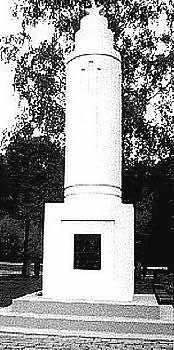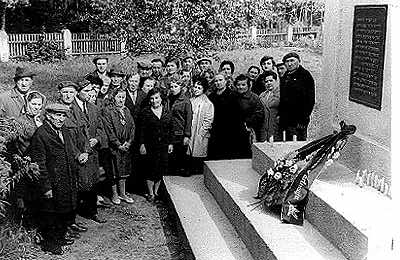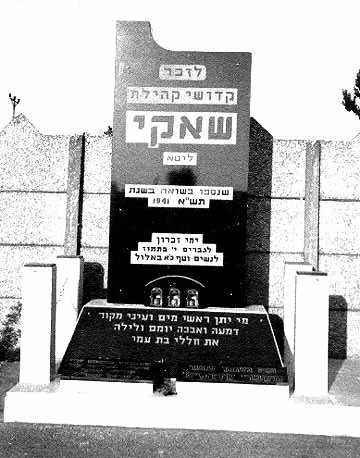The Period of World War II and Thereafter
After the German army had occupied Poland in September 1939 and with the Ribbentrop-Molotov treaty, the Russians occupied the Suvalk region, but after the delineation of exact borders between Poland, Russia and Germany, this region fell into German hands. The retreating Russians allowed anyone who wanted to join them to move into their occupied territory, and indeed many young Jewish people left the area together with the Russians. The Germans expelled the remaining Jews from their homes, robbed them of their possessions, then directed them to the Lithuanian border, where they were left in dire poverty. The Lithuanians did not allow them to enter Lithuania and the Germans did not allow them back. Thus they stayed in this swampy area in cold and rain for several weeks, until Jewish youths from the border villages in Lithuania smuggled them into Lithuania by various routes, at much risk to themselves. Altogether about 2,400 refugees crossed through or infiltrated on their own, and were then dispersed in Lithuania. In Shaki alone 100 refugees were accommodated and given a warm welcome and loyal assistance for which Lithuanian Jews were famous.
In June 1940 Lithuania was annexed to the Soviet Union and became a Soviet Republic. According to Soviet economic policy some factories and 7 Jewish shops were nationalized and commissars were appointed to run them. Supply of goods was restricted, as a result of which prices soared, and the middle class, mostly Jewish, was badly hit with its living standard dropping gradually. The Zionist parties and youth organizations were dispersed and some of its members were absorbed in the Comsomol - the Communist Youth Organization. The Hebrew school was closed and in its stead a Yiddish school opened.
In the middle of June 1941 five Jewish families whose shops had been nationalized, were exiled deep into Russia (Hirshl Rubinstein, Shmuel Rubinstein, Aharon Marshak, Abramovitz, Shmuel Goldoft)
The German army entered Shaki on the first day of war between Germany and the Soviet Union, on June 22, 1941 at 11 o'clock. Many Jews tried to escape eastwards, but only 50 managed to escape into Russia. Many were killed on the roads and most of the escapees returned home.
With the entry of the Germans, the Lithuanian nationalists took over the rule of the town. They immediately started to plot against the Jews, and every day new orders were published restricting their civil rights: they were forbidden to maintain any contacts with non-Jews, not allowed to walk on the sidewalks or to buy food products from non-Jews, could not visit public institutions, were forced to wear yellow patches on their garments, had to hand over their radios and more. In addition, a curfew was imposed from 6 o'clock in the evening until 6 o'clock in the morning. Later all Jewish men from 15 years of age and up were ordered to present themselves for work, where they were concentrated in a big barn outside the town, near a field where the Jews used to put their cows out to pasture and thus this field was called "the Jewish pasture" (Zydlaukas). The barn was heavily guarded by armed Lithuanians, and from there groups of men were taken every day to the nearby forest in order to dig long and wide trenches.
On Saturday, July 5, 1941 (10 Tamuz 5701), group after group of men was taken out of the barn and led to the trenches. There they were forced to pull off their garments and jump into the trenches. Men who did not hurry to obey the order were pushed into the trench by force. Then all were shot by the Lithuanians.
Some of the victims tried to resist the murderers. Benjamin Rotshild, the son of the old blacksmith Yisrael-Yitzhak, when already in the trench, caught the leg of one of the murderers, dragged him into the trench and hit him badly. The Lithuanian friends of the murderer jumped into the trench, killed Benjamin and took out the badly hurt Lithuanian from the trench and transferred him to the Vilkaviskis hospital. The "crazy one of the town" Motele, who tried to escape from the massacre, was also shot by the guards.
After the murder of the men, 40 wealthy women were expelled from their houses. They were then ordered to take all their belongings with them and in particular their valuables. They were brought into the same barn and there were robbed of everything they possessed. They were forced to undress naked, then led to the trenches and cruelly murdered.
The remaining women were concentrated in the most pitiable alleys of Shaki, which was proclaimed an open Ghetto, because it was not fenced off. Despite this non-Jews were forbidden to bring in any food products, so the women had to look for food elsewhere and thus endanger themselves.
On the first day that the women were concentrated into the Ghetto, Lithuanian youngsters stormed into the Ghetto, chose 6 beautiful young girls and took them out. These girls never came back. This abduction of young women continued later too, they would be kidnapped and disappear.
Saturday, September 13, 1941 ( 21 Elul 5701), marked the end of the Jewish community of Shaki. On this day all the women and children were put on carts and brought to the barn. From there group after group was led to the trenches, where they were ordered to undress and then pushed into the trenches and shot. Their belongings were loaded on carts, brought into the town and divided among the Lithuanians. Together with the Jews of Shaki, Jews from the neighboring towns of Kruki (Kriukai), Lukshi (Luksiai), Sintovta (Sintautai), Grishkabud (Griskabudis), Sudarg (Sudargas) and others, were also murdered.
Among the victims of Sudarg were the author's aunt Mina Rosin-Hilelson, his cousin Shlomo Hilelson, his cousin Elka Hilelson-Goldberg, her husband Yehuda Goldberg and their little daughter Leah'le
After the war a monument was erected on the mass graves, with an inscription in Yiddish: "In these mass graves four thousand innocent inhabitants of Shaki and its surroundings were buried in 1941-1944 by German fascists and Lithuanian bourgeoisie nationalists. Let the bright memory of the perished live for ever in the hearts of all patriots of our homeland".

Monument at the massgraves, 1.5 km north of Shaki on the outskirts of Batiskiu forest.

Entrance gate to the site of the mass graves. The inscription in Yiddish, Lithuanian and Russian says: "At this place the Hitler murderers and their local helpers in 1941-1944 murdered about 4000 Jews, men, women and children."

Picture supplied by Nathan Gershowitz
A group of survivors of the Shaki Jewish community on a memorial meeting near the monument at the mass graves at the end of the 1960s.
Standing in the first line, from right: Shmuel Bluman, ---, Mrs. Viliosesky, Riva Altfeld, Lila Shlomovitz, Rita Shlomovitz, Gita Anachovitz-Shmulovitz, Bela Froman, Vilionsky.
Second line, from right:----, ----, Eige Kuperman, Kuperman, Altfeld (half face),
----, Chiene Vilionsky, Bezalel Rotshild, ----(with the hat), Sarah Gershovitz, ----, Nathan Gershovitz, Tuviyah Goldoft, -----, ----, Yonah Iser----.
Third line, from right: Mordechai Kuperman, -----, Roche-Basia Zilber, -----, Zilber,
Moti Gershovitz.
Almost all of these people were in the USSR during the war. Many of them died in Lithuania and some of them in Israel.

Monument in memory of the murdered Jewish community of Shaki erected in the Holon cemetery.
The inscription in Hebrew: "In memory of the martyrs of Shaki Lithuania who perished in the Holocaust in year 5701- 1941."
Memorial day of the men, 10 Tamuz, of the women and children 21 Elul.
In 1959 there were 2,944 people in Shaki, but not one Jew!
Bibliography:
Yad-Vashem Archives: M-1/Q-1791/358; M-1/E-1275/1241; M-9/15(6);
Koniuchovsky collection 0-71, Files151, 152, 153.
Central Zionist Archives: 55/1701; 55/1788; 13/15/131; Z-4/2548.
The Ya'akov Oleisky Book (Hebrew)-published by "ORT" Israel and "The Association of Lithuanian Jews in Israel". Tel-Aviv 1986.
The Small Lithuanian Encyclopedia (Lithuanian), Vilnius 1966-1971.
The Lithuanian Encyclopedia (Lithuanian)-Boston 1953-1965.
Lite (Yiddish), New-York 1951, volume 1 & 2.
Yahaduth Lita (Hebrew), Tel-Aviv, volumes 1-4.
Dos Vort (Yiddish Daily)- Kovno, 11.11.1934, 30.11.1934, 23.12.1934.
Di Yiddishe Shtime (Daily)- Kovno, 30.1.1928, 3.2.1928, 14.3.1928, 26.2.1928, 27.2.1928, 5.6.1928, 26.6.1928, 26.5.1931, 9.9.1937.
HaMeilitz (Hebrew)-St.Petersburg, 20.5.1879, 10.6.1879, 22.6.1880, 1.8.1882, 19.2.1883, 16.3.1883, 16.4.1883, 10.6.1883, 4.12.1886, 8.12.1886.
Yiddisher Hantverker (Yiddish)-Kovno, Nr. 7, 15.12.1938.
Folksblat (daily) (Yiddish)-Kovno,14.2.1935, 1.5.1936, 9.9.1937, 29.10.1940.
Cohen Berl, Shtet, Shtetlach un dorfishe Yishuvim in Lite biz 1918 (Towns, small towns and rural Settlements in Lithuania till 1918) (Yiddish), New-York 1992.
Pinkas haKehiloth. Lita (Encyclopedia of the Jewish Settlements in Lithuania) (Hebrew), Editor: Dov Levin, Assistant editor: Joseph Rosin, Yad Vashem, Jerusalem 1996.
Masines Zudynes Lietuvoje (Mass Murder in Lithuania) (Lithuanian), 1941-1944, vol. 1 & 2, Vilnius.
The Book of Sorrow (Lithuanian, Hebrew, Yiddish, English), Vilnius 1997
Appendix I.
The festive opening celebration of the club of the Z"S party, "HeChalutz" and HaOved"
(excerpts from a description from the Yiddish daily newspaper "Dos Vort", 11 November 1934).
The chairman of the evening was Alter Pakeltzik. Speeches were held by Shachne Kruk on behalf of the Z"S party, by Shlomo Shapira on behalf of "haOved", by Zvi Gefen on behalf of Keren haYesod , byYisrael Bluman on behalf of "Keren Kayemeth (KKL)", by Chaviva Kovensky on behalf of "HaChalutz HaTsair", byYosef Ziman on behalf of the Neishtot branch of "HeChalutz" and by Shifrah and Zusman on behalf of the Kibbutz "HaMetsaref". Mordechai Vilionsky held a speech in which he asked the members of the party to strengthen activities for it and the National Funds.
Appendix II.
A Partial List of Personalities born in Shaki.
Yitzhak-Leib Goldberg (1860-1935), one of the pioneers of "Chovevei Zion" (Lovers of Zion) in Vilna, from 1890 and for 25 years the representative of the "Odessa Committee", delegate on behalf of Vilna to the first Zionist congress, supported the Hebrew press in Russia and in Eretz Yisrael, The Hebrew University in Jerusalem was built on his land.
Boris Goldberg (1866-1921), one of the leaders of the Zionists in Russia, journalist and member of many editorial boards of newspapers in Russia and London, from 1920 in Eretz Yisrael.
Yehudah Fin (1866-1945), workers leader in England and America.
Nachman-Ber Etelzon (1828-1920), one of the first Jewish journalists in Chicago and New-York, published the first Yiddish newspaper in Chicago in 1870:"Di Israelitishe Presse" with a supplement in Hebrew "Heichal HaIvriyah", later moving it to New York.
Yosef Even-Odem (1907-1962), M.D. son of Rabbi and Senator Yitzhak Rubinstein from Vilna, from 1933 in Eretz Yisrael, published many books on Hebrew terminology of medicine and nature.
Aharon Fridman (1855-1932), cantor in Berlin 1882-1932, was awarded a special title by the German authorities.
Yosef-Irving Pascal (1890-?), M.D., immigrated to America, developed some inventions in the field of Ophthalmology , published a few books on this topic.
Ya'akov Oleisky (1901-1981), agronomist, director of "ORT' in Lithuania and later in Israel, for many years the chairman of "The Association of Lithuanian Jews in Israel"
Chanah Vurtzel (1872-?), from 1902 in America, published poems in the Jewish newspapers "Forverts", "Togeblat", "Morgen Jurnal" etc.
Chayim Saks (1887-1941), journalist, published articles in the Jewish press in Kovno, murdered in 1941.
Aryeh-David Berezovsky, a known cantor.
Return
to the Shaki Shtetlinks Page
Return to the Shaki Shtetlinks Page